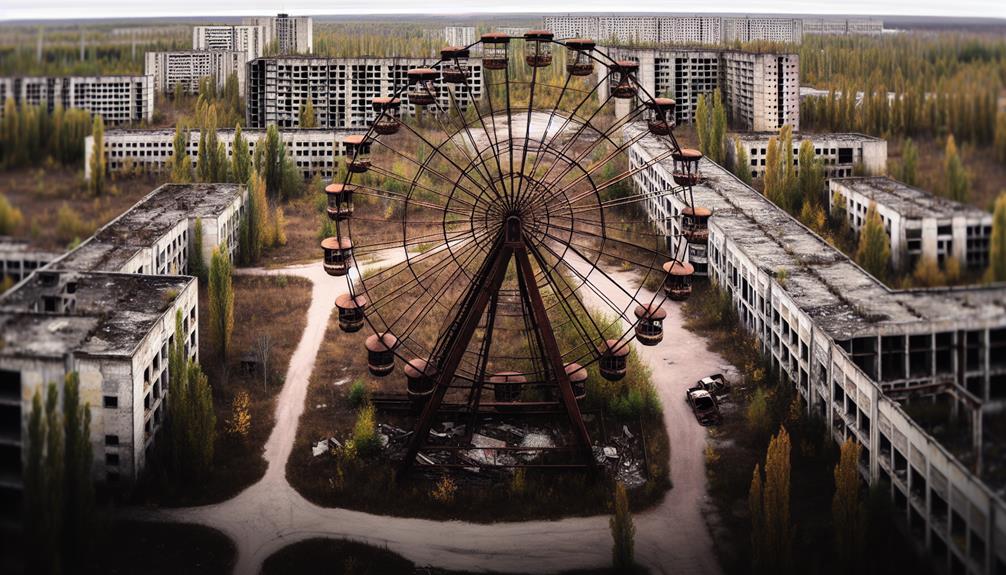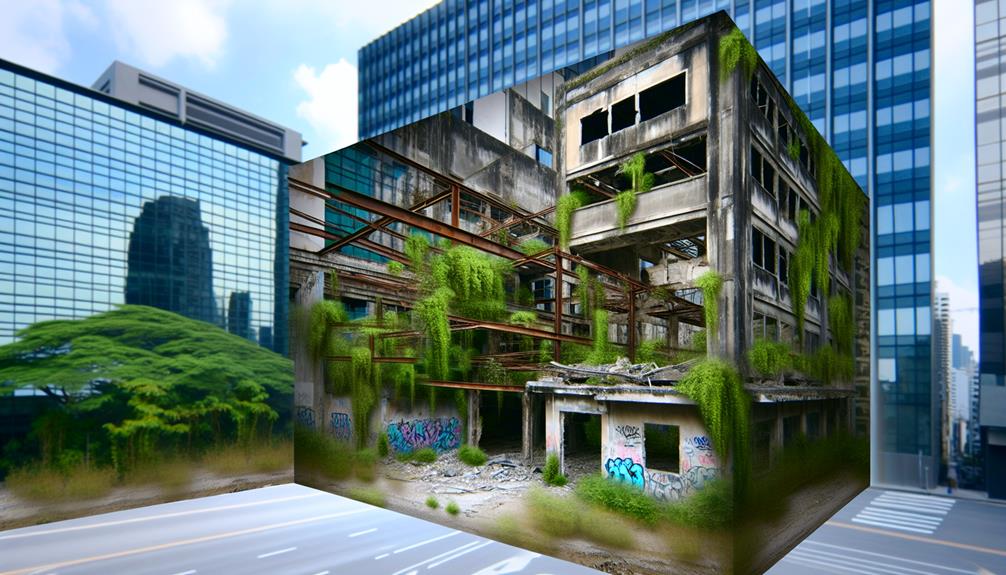The shadow of the Chernobyl disaster looms large over Pripyat, Ukraine, casting a haunting veil over its once vibrant streets. As the city stands frozen in time, abandoned buildings and structures whisper tales of a community abruptly disrupted. The allure of this ghost town extends beyond its eerie atmosphere; it serves as a proof to the resilience of nature in the face of adversity. Amidst the remnants of human habitation, wildlife now thrives, offering a glimpse into a world where the past and present intersect in a delicate balance.
Key Takeaways
- Established near Chernobyl, Pripyat was a vibrant city until the Chernobyl disaster in 1986.
- Known for its abandoned buildings, Pripyat attracts urban explorers fascinated by its haunting legacy.
- Wildlife thrives in the exclusion zone, making Pripyat a unique living laboratory for studying radiation's effects.
- Guided tours with safety protocols allow visitors to explore Pripyat, a hub for urban exploration.
- Ongoing recovery efforts aim to decontaminate and preserve Pripyat, balancing challenges with opportunities for its future.
History of Pripyat
Located near the Chernobyl Nuclear Power Plant, Pripyat holds a significant historical background that dates back to its establishment in the mid-20th century. The city was founded on February 4, 1970, to accommodate workers and families of the nuclear plant. Pripyat quickly grew into a bustling urban center, with modern amenities such as schools, hospitals, and recreational facilities. The city's population consisted mainly of young families and professionals working at the nearby power plant. Pripyat's cultural significance stemmed from its vibrant community life, with theaters, cinemas, and sports facilities contributing to a rich social fabric.
The impact on residents was profound, as Pripyat represented a symbol of Soviet progress and modernity. Families relocated to the city in pursuit of better opportunities, only to have their lives disrupted by the Chernobyl disaster in 1986. The abrupt evacuation of Pripyat's residents left behind a ghost town frozen in time, with personal belongings and remnants of daily life scattered throughout the deserted streets. The cultural significance of Pripyat lies in its tragic legacy, serving as a somber reminder of the devastating consequences of nuclear accidents on both human lives and urban landscapes.
Chernobyl Disaster Impact
The aftermath of the Chernobyl disaster left a lasting impact on the region, reshaping not just the physical landscape but also the socio-economic fabric of the affected areas. The long term effects and environmental consequences of the disaster are profound:
- Health Impact: The most immediate and devastating impact of the Chernobyl disaster was on human health. Thousands of cases of thyroid cancer and other radiation-related illnesses have been reported in the years following the incident.
- Economic Disruption: The economic repercussions were significant, with a vast area around Chernobyl being rendered uninhabitable. The loss of agricultural land and the need for ongoing monitoring and cleanup efforts have had a lasting impact on the local economy.
- Wildlife Effects: The environmental consequences of the disaster are still being seen today. The wildlife in the region has been affected, with mutations and disruptions to the ecosystem observed in the years since the incident.
- Continued Monitoring: The need for continued monitoring and management of the Chernobyl Exclusion Zone is essential to mitigate the long term environmental impacts of the disaster. Efforts are ongoing to understand and address the lasting effects of the Chernobyl nuclear accident.
Abandoned Buildings and Structures
The aftermath of the Chernobyl disaster has left a haunting legacy of abandoned buildings and structures that now stand as eerie remnants of a bygone era. Urban exploration enthusiasts are drawn to Pripyat to witness firsthand the effects of architectural decay on the structures within the exclusion zone. These abandoned buildings tell a story of a once-vital medical facility frozen in time, offering a glimpse into the lives of its former inhabitants.
| Building | Description | Condition |
|---|---|---|
| Hospital No. 126 | Once a vital medical facility, now a shell of its former self. | Decaying walls |
| Azure Swimming Pool | Once a vibrant leisure spot, now filled with debris and stagnant water. | Cracked tiles |
| Polissya Hotel | Once a luxury accommodation, now a crumbling structure with nature reclaiming it. | Collapsing roof |
| Palace of Culture Energetik | Once a hub of cultural activities, now a shadow of its former glory. | Broken windows |
The allure of exploring these abandoned buildings lies in the opportunity to witness firsthand the consequences of a catastrophic event on the urban landscape. As visitors navigate through the decaying structures, they are reminded of the fragility of human achievement in the face of natural disasters. The architectural decay serves as a poignant reminder of the transient nature of civilization, prompting reflection on the impermanence of human endeavors.
Ghost Town Atmosphere
An eerie ambiance pervades the desolate streets of Pripyat, Ukraine, evoking a ghostly presence that lingers amidst the abandoned remnants of a once-thriving city. This ghost town atmosphere draws in urban explorers and those seeking haunted attractions, all captivated by the eerie silence that envelops the surroundings. Here are some aspects that contribute to the haunting allure of Pripyat:
- Paranormal Encounters: Many visitors report unexplained phenomena and encounters in Pripyat, adding to the mysterious aura of the ghost town. From strange noises to sightings of apparitions, these experiences fuel the belief that the spirits of the past residents still wander the empty streets.
- Eerie Silence: The absence of human activity creates a profound silence that hangs heavy in the air. The quietness amplifies the sense of abandonment and desolation, intensifying the feeling of being in a place frozen in time.
- Haunted Attractions: Pripyat's abandoned buildings, overgrown amusement park, and decaying structures have become popular destinations for thrill-seekers looking to explore eerie and haunted locations. The allure of the unknown and the spine-chilling atmosphere attract those fascinated by the macabre.
- Urban Exploration: The decaying infrastructure and remnants of a bygone era offer urban adventurers a unique opportunity to investigate the history and tragedy of Pripyat. The deserted buildings and streets serve as a backdrop for adventurers seeking to uncover the secrets hidden within the ghost town.
Wildlife and Nature Reclamation
Amidst the abandoned structures of Pripyat, a silent transformation unfolds as wildlife slowly reclaims its territory, weaving a new tapestry of nature within the ghostly city. Following the catastrophic Chernobyl nuclear disaster in 1986, the exclusion zone surrounding the area has inadvertently become a haven for wildlife preservation and ecological restoration. The absence of human activity has allowed nature to flourish, with species once scarce in the region now thriving.
In the years since the disaster, Pripyat has seen an unexpected resurgence of wildlife. The Chernobyl Exclusion Zone has become a unique ecosystem where animals roam freely without the threat of human interference. Wolves, deer, boars, and numerous bird species have reclaimed the land, exhibiting a remarkable ability to adapt and survive in this post-apocalyptic environment.
Despite the lingering radiation, studies have shown that wildlife in the exclusion zone is not only surviving but also thriving. This phenomenon has sparked interest among scientists and conservationists, who view the area as a living laboratory for understanding the long-term effects of radiation exposure on wildlife.
Efforts to monitor and study the wildlife in Pripyat and the surrounding exclusion zone are ongoing, providing valuable insights into the resilience of nature in the face of environmental catastrophe. The inadvertent rewilding of Pripyat serves as a poignant reminder of nature's ability to rebound and reclaim even the most desolate of landscapes.
Tourist Visits and Restrictions
Exploring the impact of tourist visits and the associated restrictions within Pripyat, Ukraine presents a nuanced examination of the delicate balance between preservation and accessibility in a post-nuclear disaster environment.
- Tourist Experience: Visitors to Pripyat have the opportunity to witness firsthand the haunting remnants of a city frozen in time since the Chernobyl disaster. Local guides provide valuable insights into the history and significance of each location, enriching the overall experience.
- Local Guides: These knowledgeable guides not only safeguard the safety of tourists but also offer unique perspectives and personal anecdotes that bring the ghost town to life. Their presence adds depth and authenticity to the exploration of Pripyat.
- Photography Tips: Capturing the essence of Pripyat requires a careful balance of sensitivity and creativity. Photography enthusiasts can benefit from tips on lighting, angles, and composition to create compelling visual narratives that reflect the eerie beauty of the abandoned city.
- Hidden Gems: Beyond the well-known landmarks, Pripyat harbors hidden gems waiting to be discovered. From forgotten artifacts to overgrown playgrounds, these lesser-known sites offer a glimpse into the everyday lives of Pripyat's former residents, adding layers of intrigue to the visitor experience.
In maneuvering the complexities of tourism in Pripyat, respecting the past while embracing the present is crucial to make certain that future generations can appreciate and learn from this tragic chapter in history.
Radiation Levels and Safety
When evaluating the safety measures and radiation levels within Pripyat, Ukraine, an important aspect of comprehending the ongoing impact of the Chernobyl disaster is to contemplate the potential risks posed to visitors and the environment in this post-nuclear disaster setting. Radiation monitoring plays a vital role in ensuring the safety of individuals entering the exclusion zone. Various checkpoints and monitoring stations are set up to track radiation levels continuously. These measurements help authorities determine safe zones for visitors and restrict access to highly contaminated areas.
Protective gear is mandatory for anyone entering the exclusion zone. This gear typically includes full-body suits, respirators, gloves, and shoe covers to minimize direct contact with contaminated surfaces and prevent the inhalation of radioactive particles. Visitors are also advised to shower and change clothes after their visit to reduce the risk of carrying radioactive materials outside the zone.
It is essential for visitors to adhere to the guidance provided by trained professionals during their visit to Pripyat. Ignoring safety protocols or venturing off-limits can result in dangerous exposure to radiation. While guided tours offer a structured and safer way to explore the area, it is crucial to respect the rules and regulations in place to protect both individuals and the environment from the lasting effects of the Chernobyl disaster.
Evacuation and Aftermath
Following the Chernobyl disaster in 1986, the evacuation of Pripyat, Ukraine, marked a critical moment in the aftermath of the nuclear catastrophe. The evacuation process faced several challenges, including:
- Immediate Evacuation: The residents of Pripyat were forced to leave their homes with minimal belongings, not fully grasping the gravity of the situation. This sudden displacement caused confusion and fear among the population.
- Logistical Difficulties: Coordinating the evacuation of a city the size of Pripyat was a monumental task. Lack of transportation, communication breakdowns, and the need to guarantee the safety of all residents posed significant challenges.
- Psychological Impact: The trauma of being uprooted from their homes, coupled with the uncertainty of their future and the health risks they faced, left a lasting psychological impact on the evacuees. Many experienced feelings of loss, anxiety, and hopelessness.
- Long-Term Effects: The evacuation of Pripyat was not a one-time event but had enduring consequences. The displaced residents faced challenges in resettlement, health issues related to radiation exposure, and the emotional scars of the disaster.
The evacuation of Pripyat was a complex and harrowing ordeal that continues to resonate today through its long-term effects on the lives of those who were forced to leave.
Future of Pripyat
Looking ahead, the future of Pripyat poses complex challenges and opportunities in the wake of the Chernobyl disaster. The town remains abandoned since the evacuation following the nuclear accident, but discussions about its future have been ongoing.
One aspect of Pripyat's future is the ongoing recovery efforts taking place in the area. Various organizations and governments are working towards making the region safe and habitable again. This involves decontamination processes, infrastructure improvements, and environmental remediation. These efforts aim to restore some sense of normalcy to the area and potentially allow for limited human activity in the future.
On the other hand, Pripyat has also become a hub for urban exploration, attracting adventurers and tourists from around the world. The abandoned buildings and eerie atmosphere offer a unique experience for those willing to explore the town. However, this raises concerns about the preservation of the site and the potential risks involved in entering unstable structures.
To provide a more in-depth view of the challenges and opportunities facing Pripyat, the table below outlines key points related to its future:
| Aspect | Challenges | Opportunities |
|---|---|---|
| Recovery Efforts | Decontamination and safety concerns | Restoration of the area for human activity |
| Urban Exploration | Preservation of the site | Tourism and interest in the town |
| Infrastructure | Rebuilding and modernizing infrastructure | Sustainable development plans |
Frequently Asked Questions
Can Tourists Visit the Chernobyl Nuclear Power Plant?
Tourists visiting the Chernobyl nuclear power plant must consider the potential radiation effects and prioritize their safety. Exposure to radiation can have severe health consequences, making it important for visitors to follow safety protocols and guidelines.
Understanding the risks associated with radiation exposure and adhering to safety measures can help guarantee a safe and informative visit to the site. Prioritizing safety is paramount when exploring areas with potential radiation hazards.
Are There Any Restrictions on Photography in Pripyat?
Photography guidelines in certain destinations can shape the tourist experience, offering a framework for artistic expression while respecting local customs and privacy. Understanding restrictions on photography enhances cultural immersion and fosters respectful interactions with the environment.
These guidelines often serve as a bridge between personal freedom and communal harmony, ensuring that visitors can capture memorable moments without infringing on the rights or sensitivities of others.
What Is the Current Population of Pripyat?
Population data is vital for understanding the demographic changes within a specific region. By analyzing the current population figures, researchers can gain insight into trends, growth patterns, and sociodemographic shifts.
This data serves as a foundational element for policymakers, urban planners, and social scientists to make informed decisions regarding resource allocation, infrastructure development, and social programs.
Understanding the population dynamics of a place is essential for fostering sustainable growth and addressing societal needs effectively.
Are There Any Plans to Rebuild Pripyat in the Future?
Plans for rebuilding Pripyat in the future remain speculative, with discussions revolving around the feasibility of restoring infrastructure and ensuring safety for potential tourism.
The concept of resurrecting a once-abandoned city carries a weight of symbolism, promising a declaration of resilience and renewal.
The allure of a revitalized Pripyat as a destination for visitors underscores the potential for economic growth and the preservation of historical significance in the region.
How Has Wildlife Adapted to the Radiation in Pripyat?
Animals exposed to high levels of radiation have been known to develop mutations as a result of genetic damage. These mutations can manifest in various ways, affecting physical appearance, behavior, and reproductive capabilities.
In response to such challenges, wildlife may employ survival strategies such as altered foraging habits or changes in breeding patterns.
These ecological impacts can lead to shifts in population dynamics and biodiversity within the affected area.
Conclusion
To sum up, the haunting history of Pripyat, Ukraine, serves as a reminder of the devastating impact of the Chernobyl disaster.
The abandoned buildings and structures, coupled with the reclamation of nature and wildlife, create a ghost town atmosphere that attracts visitors and researchers alike.
The ongoing recovery efforts and guided tours guarantee the safety of those exploring this eerie location, while also providing valuable insights into the long-term effects of radiation exposure.


